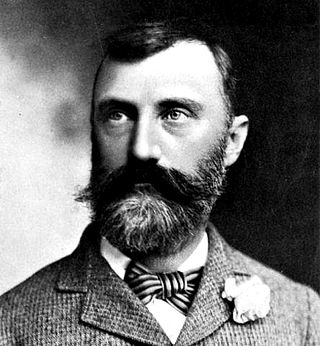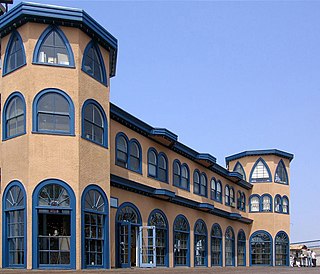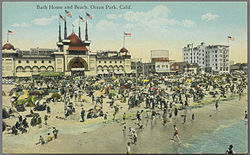
Santa Monica is a city in Los Angeles County, situated along Santa Monica Bay on California's South Coast. Santa Monica's 2020 U.S. Census population was 93,076. Santa Monica is a popular resort town, owing to its climate, beaches, and hospitality industry. It has a diverse economy, hosting headquarters of companies such as Hulu, Activision Blizzard, Universal Music Group, Lionsgate, Illumination and The Recording Academy.

Venice is a neighborhood of the City of Los Angeles within the Westside region of Los Angeles County, California, United States.

Pacific Palisades is a neighborhood in the Westside region of Los Angeles, California, situated about 20 miles (32 km) west of Downtown Los Angeles.

The Santa Monica Pier is a large pier at the foot of Colorado Avenue in Santa Monica, California, United States. It contains a small amusement park, concession stands, and areas for views and fishing. The pier is part of the greater Santa Monica Mountains National Recreation Area.
The history of Santa Monica, California, covers the significant events and movements in Santa Monica's past.

The Third Street Promenade is a pedestrian mall esplanade, shopping, dining and entertainment complex in the downtown area of Santa Monica, California which originally opened as the Santa Monica Mall on November 8, 1965. It is considered a premier shopping and dining district on the Westside and draws crowds from all over the Greater Los Angeles area. Due to easy access to Downtown Los Angeles via the Big Blue Bus rapid transit service, E Line's terminus station and the Pacific Coast Highway-Santa Monica Freeway Interstate, the neighborhood's north-south thoroughfares connecting to Muscle Beach, Venice Canal Historic District, Marina del Rey, Ballona Wetlands and Los Angeles International Airport, and its proximity to historic U.S. Route 66, Santa Monica Pier, Palisades Park, Tongva Park, Santa Monica State Beach and the Pacific Ocean coupled with Los Angeles's mild mediterranean climate, it is also a popular tourist destination.

The Marvin Braude Bike Trail is a 22-mile (35 km) paved bicycle path that runs mostly along the shoreline of Santa Monica Bay in Los Angeles County, California. The coastal bike trail is widely acknowledged as Los Angeles’ “most popular bike path.”

Ocean Avenue is a road in Santa Monica, California that starts at the residential Adelaide Drive on the north end of Santa Monica and ends at Pico Boulevard. Ocean Avenue is the westernmost street in Santa Monica, and for most of its course it runs parallel to Palisades Park, whose bluffs overlook Pacific Coast Highway and Santa Monica State Beach.
The western border of Santa Monica, California, is the 3-mile (4.8 km) stretch of Santa Monica Bay. On its other sides, the city is bordered by various districts of Los Angeles: the northwestern border is Pacific Palisades, the eastern border is Brentwood north of Wilshire Boulevard and West Los Angeles south of Wilshire, the northeastern border is generally San Vicente Boulevard up to the Riviera Country Club, the southwestern border is Venice Beach and the southern border is with West Los Angeles and Mar Vista.

Abbot Kinney was an American developer, conservationist, water supply expert and tree expert. Kinney is best known for his "Venice of America" development in Los Angeles.

Charles I. D. Looff was a Danish master carver and builder of hand-carved carousels and amusement rides, who immigrated to the United States of America in 1870. Looff built the first carousel at Coney Island in 1876. During his lifetime, he built over 40 carousels, several amusements parks, numerous roller coasters and Ferris wheels, and built California's famous Santa Monica Pier. He became famous for creating the unique Coney Island style of carousel carving.

The Santa Monica Looff Hippodrome is located on the Newcomb Pier adjacent to the Santa Monica Pier in Santa Monica, California. It was designed and built in 1916 by Charles I. D. Looff and his son Arthur to hold a Looff Carousel. Looff's carousel was housed at the Hippodrome until it was sold in 1939. It was replaced by Philadelphia Toboggan Company Carousel #62, which was moved from the Ocean Park Pier. The building remains a rare example of structures that used to be on the amusement pier, and scenes were filmed therein for the 1973 award-winning film, The Sting. Since 1977, the carousel has been owned by the city, and was restored from 1977 through 1981. It was declared a National Historic Landmark in 1987.
The Aragon Ballroom on Lick Pier in the Ocean Park district of Santa Monica, California was a social-dance venue opened under the Aragon name in March 1942 by dance promoter Harry Schooler (1918–2008).

Santa Monica State Beach is a California State Park operated by the city of Santa Monica.

Jessie's Critter Carousel is a carousel at Disney California Adventure at the Disneyland Resort in Anaheim, California. The attraction opened to the public as King Triton's Carousel of the Sea on February 8, 2001.

The Los Angeles Pacific Railroad (1896−1911) (LAP) was an electric public transit and freight railway system in Los Angeles County, California. At its peak it had 230 miles (370 km) of track extending from Downtown Los Angeles to the Westside, Santa Monica, and the South Bay towns along Santa Monica Bay.

The Long Wharf in Santa Monica, also known as Port Los Angeles or the Mile Long Pier, was an extensive pier wharf constructed by the Southern Pacific Railroad Company in Santa Monica Bay from 1892 to 1894. When it opened in 1894, it was the longest wharf in the world, measuring approximately 4,700 feet (1,400 m). It served as a cargo and passenger port until 1913, and in 1919 removal of the wharf started. The wharf, the 1,000 foot (300 m) tip of the pier, was removed by 1920. The remaining 3,600 feet (1,100 m) of pier was used as a run down fishing pier until 1933, when the remainder of the pier was removed. One of the major imports to the wharf was lumber from Northern ports, to help in the construction boom in Southern California. Southern Pacific Railroad and the street cars of the Los Angeles Pacific Railroad served the wharf. Los Angeles Pacific Railroad ran passenger trams to the wharf and from midnight to sunrise ran cargo cars.
Oakwood is a residential neighborhood that abuts the east side of Abbot Kinney Boulevard. It is within the larger neighborhood of Venice on the westside of Los Angeles, California. The area is noted as an "important example of African-American life in Southern California during the early 20th century". The neighborhood has alternately been referred to as "Ghost Town", "Dogtown" and the "Oakwood Pentagon". It contains one Los Angeles Historic-Cultural Monument.

The Venice Vanguard was a newspaper circulated in Venice, California, beginning in 1907. By 1984 it had become a "throwaway shopper."

Fraser's Million Dollar Pier was a 20th-century amusement park in Ocean Park, California in the United States. The pier was located between Pier Avenue and Marine Street, in a community situated between Santa Monica and Venice in Los Angeles County. Developed by A. H. Fraser, a booster in Ocean Park who had formerly been business partners with Abbot Kinney of Venice, the pier opened to the public on June 17, 1911, and was destroyed September 3, 1912, in a catastrophic fire that spread into the adjacent neighborhood and destroyed six to eight square blocks.




















